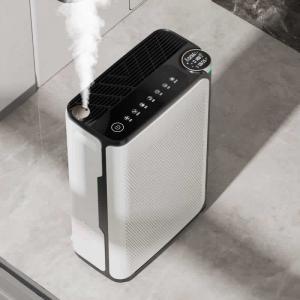

Add to Cart

Electrical Home Appliances Hepa UV Lamps Air Purifier With Spray Humidifier
Hepa UV Air Purifier Description
| Name | Hepa UV Air Purifier |
| Model | XT-KJ520Y |
| Sensor | CO2/Humidity/TVOC/Temperature/Formaldehyde/Dust Sensor |
| Motor | Nidec DC Motor |
| Voltage | 100-240V |
| Power | 115W |
| Color | White |
| Material | High Quality ABS |
New Hepa UV Air Purifier With 6 Sensors!
CO2 Sensor: This sensor measures the level of carbon dioxide (CO2) in the air. High levels of CO2 can indicate poor ventilation or the presence of other pollutants, which can affect indoor air quality and cause discomfort or health issues.
Humidity Sensor: The humidity sensor measures the amount of moisture present in the
air. Maintaining an optimal humidity level is important for comfort
and to prevent issues like mold growth. Too high or too low
humidity levels can contribute to respiratory problems or damage to
furniture and other items.
TVOC Sensor: Total Volatile Organic Compounds (TVOCs) are organic chemicals
that can be released from various sources like paints, cleaning
products, and building materials. TVOC sensors detect and measure
the presence of these compounds, helping to identify potential
indoor pollutants.
Temperature Sensor: The temperature sensor measures the ambient temperature of the
room. It allows the air purifier to adjust its operation based on
the temperature conditions and can contribute to a more comfortable
indoor environment.
Formaldehyde Sensor: Formaldehyde is a common indoor air pollutant found in building
materials, furniture, and household products. The formaldehyde
sensor detects and measures the levels of this chemical, which can
be harmful if present in high concentrations.
Dust Sensor: The dust sensor detects and measures the amount of particulate
matter or dust present in the air. This information helps to
determine the effectiveness of the air purifier in removing dust
particles, which can cause respiratory issues and allergies.
By incorporating these six sensors, the air purifier can gather
comprehensive data about the indoor air quality and make
adjustments to provide the best purification and filtration
performance. This ensures that the air you breathe is clean,
healthy, and free from potential pollutants.
Hepa UV Air Purifier Function
A HEPA UV air purifier combines two key technologies to improve indoor air quality: High-Efficiency Particulate Air (HEPA) filtration and ultraviolet (UV) germicidal irradiation. Let's explore how each of these functions works:
HEPA Filtration: HEPA filters are highly efficient at capturing and trapping
airborne particles, including dust, allergens, pet dander, pollen,
mold spores, and some bacteria and viruses. These filters are
designed to remove particles as small as 0.3 microns with an
efficiency of 99.97%. HEPA filters work by using a dense mat of
fibers that create a labyrinth-like structure, allowing air to pass
through while capturing and trapping particles. This filtration
process helps to improve overall air quality by reducing the
presence of harmful particles.
UV Germicidal Irradiation: Ultraviolet germicidal irradiation, commonly known as UV-C light,
is a technique used to kill or deactivate microorganisms, including
bacteria, viruses, and mold spores. UV-C light has a specific
wavelength that disrupts the DNA and RNA of these microorganisms,
rendering them unable to reproduce and causing their demise. When
integrated into an air purifier, UV-C lamps are strategically
positioned to expose the air passing through the system to this
germicidal light. This process helps to eliminate or reduce the
concentration of harmful microorganisms in the air.
By combining HEPA filtration and UV germicidal irradiation, a HEPA
UV air purifier can effectively remove both particulate matter and
microorganisms from the air. The HEPA filter captures and traps
particles, while the UV-C light works to neutralize harmful
microorganisms. This dual approach helps to create a healthier
indoor environment by reducing the presence of allergens,
pollutants, and potentially harmful bacteria and viruses. It's
important to note that UV-C light should be used in conjunction
with other air purification technologies and is not a standalone
solution for air purification.
